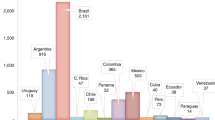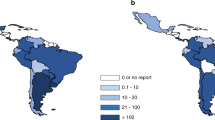Abstract
Haematopoietic cell transplants are done by more than 1500 transplant centres in 75 countries, mostly for life-threatening haematological disorders. However, transplant technology and access are not uniformly distributed worldwide. Most transplants are done predominately in Europe, North America and some Asian countries. We review transplant activity in Latin America, a geographic region with a population of >600 million persons living in countries with diverse economic and social development levels. These data indicate a 20–40-fold lower frequency of transplants in Latin America compared with Europe and North America. We show that although economics, infrastructure and expertise are important limitations, other variables also operate. Changes in several of these variables may substantially increase transplant activity in Latin America.
This is a preview of subscription content, access via your institution
Access options
Subscribe to this journal
Receive 12 print issues and online access
$259.00 per year
only $21.58 per issue
Buy this article
- Purchase on Springer Link
- Instant access to full article PDF
Prices may be subject to local taxes which are calculated during checkout





Similar content being viewed by others
References
Gratwohl A, Pasquini MC, Aljurf M, Atsuta Y, Baldomero H, Foeken L . One million haemopoietic stem-cell transplants: a retrospective observational study for the Worldwide Network for Blood and Marrow Transplantation (WBMT). Lancet Haematol 2015; 2: e91–e100.
Carnot-Uria J . Achievements and perspectives of stem cell transplantation in Cuba. Rev Cubana Hematol Immunol Hemoter 2012; 28: 108–110.
Ruiz-Arguelles GJ, Tarin-Arzaga LC, Gonzalez-Carillo ML, Gutierrez-Riveroll KI, Rangel-Malo R, Gutierrez-Aguirre CH et al. Therapeutic choices in patients with Ph-positive CML living in Mexico in the tyrosine kinase inhibitor era: SCT or TKIs? Bone Marrow Transplant 2008; 42: 23–28.
Nucci M, Garnica M, Gloria AB, Lehugeur DS, Dias VC, Palma LC et al. Invasive fungal diseases in haematopoietic cell transplant recipients and in patients with acute myeloid leukaemia or myelodysplasia in Brazil. Clin Microbiol Infect 2013; 19: 745–751.
Machado CM, Martins TC, Colturato I, Souza M, Anderson JS, Souza MP . Epidemiology of neglected tropical diseases in transplant recipients. Review of the literature and experience of a Brazilian HSCT center. Rev Inst Med trop Sao Paulo 2009; 51: 309–324.
Pasquini MC, Zhu X . Current use and outcome of hematopoietic stem cell transplantation. CIBMTR Summary Slides, 2014. Available at http://www.cibmtr.org.
Gragert L, Eapen M, Williams E, Freeman J, Spellman S, Baitty R et al. HLA match likelihoods for hematopoietic stem-cell grafts in the U.S. registry. N Engl J Med 2014; 371: 339–348.
Ruiz A, Ruiz-Argüelles GJ . A Mexican way to cope with stem cell grafting. Hematology 2012; 17: S195–S197.
Gutiérrez-Aguirre CH, Gómez-De-León A, Alatorre-Ricardo J, Cantú-Rodríguez OG, González-Llano O, Jaime-Pérez JC et al. Allogeneic peripheral blood stem cell transplantation using reduced-intensity conditioning in an outpatient setting in ABO-incompatible patients: are survival and graft-versus-host disease different? Transfusion 2014; 54: 1269–1277.
González-Llano O, Rodríguez-Romo LN, Mancías-Guerra Mdel C, Tarín-Arzaga L, Jaime-Pérez JC, Herrera-Garza JL et al. Feasibility of an outpatient HLA haploidentical stem cell transplantation program in children using a reduced-intensity conditioning regimen and CD3-CD19 depletion. Hematology 2014; 19: 10–17.
Jaime-Pérez JC, Heredia-Salazar AC, Cantú-Rodríguez OG, Gutiérrez-Aguirre H, Villarreal-Villarreal CD, Mancías-Guerra C et al. Cost structure and clinical outcome of a stem cell transplantation program in a developing country: the experience in Northeast Mexico. Oncologist 2015; 20: 386–392.
Woolhandler S, Himmelstein DU, Labar B, Lang S . Transplanted technology: Third World options and First World science. N Engl J Med 1987; 317: 504–506.
Galeano E . Open Veins of Latin America. Monthly Review Press: New York, NY, USA, 1997.
Condino-Neto C, Sorensen RU, Gomez-Raccio AC, King A, Espinosa-Rosales FJ, Franco JL . Current state and future perspectives of the Latin American Society for Immunodeficiencies (LASID). http://dx.doi.org/10.1016/j.aller.2014.05.007.
Acknowledgements
The following colleagues provided helpful comments: Luis Fernando Bouzas (Instituto Nacional de Cancer–INCA, Brazil), Sebastian Galeano, Hospital Británico, Uruguay, Gregorio Jaimovich, LABMT president, Buenos Aires, Argentina, Juliana Martinez Rolon, Fundaleu, Buenos Aires, Argentina and Guillermo J Ruiz-Arguelles, Centro de Hematologia Puebla, Mexico. RPG acknowledges support from the NIHR Biomedical Research Centre funding scheme.
Author information
Authors and Affiliations
Corresponding author
Ethics declarations
Competing interests
The authors declare no conflict of interest.
Rights and permissions
About this article
Cite this article
Gale, R., Seber, A., Bonfim, C. et al. Haematopoietic cell transplants in Latin America. Bone Marrow Transplant 51, 898–905 (2016). https://doi.org/10.1038/bmt.2016.35
Received:
Revised:
Accepted:
Published:
Issue Date:
DOI: https://doi.org/10.1038/bmt.2016.35
This article is cited by
-
Increasing access to hematopoietic cell transplantation in Latin America: results of the 2018 LABMT activity survey and trends since 2012
Bone Marrow Transplantation (2022)
-
The paradox of haematopoietic cell transplant in Latin America
Bone Marrow Transplantation (2021)
-
Challenges in Chronic Myeloid Leukemia Management in South America
Current Hematologic Malignancy Reports (2021)
-
Lack of information about umbilical cord blood banking leads to decreased donation rates among Brazilian pregnant women
Cell and Tissue Banking (2021)
-
Building a hematopoietic cell transplantation outcomes registry in Mexico
Bone Marrow Transplantation (2020)



